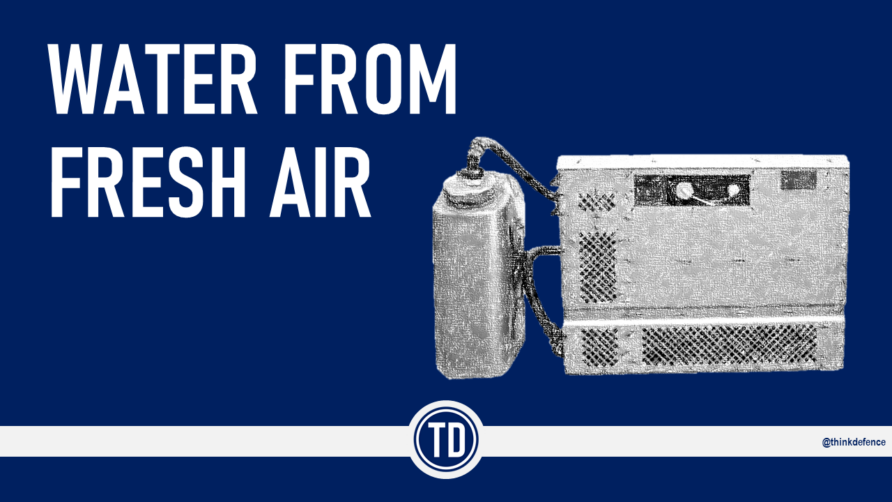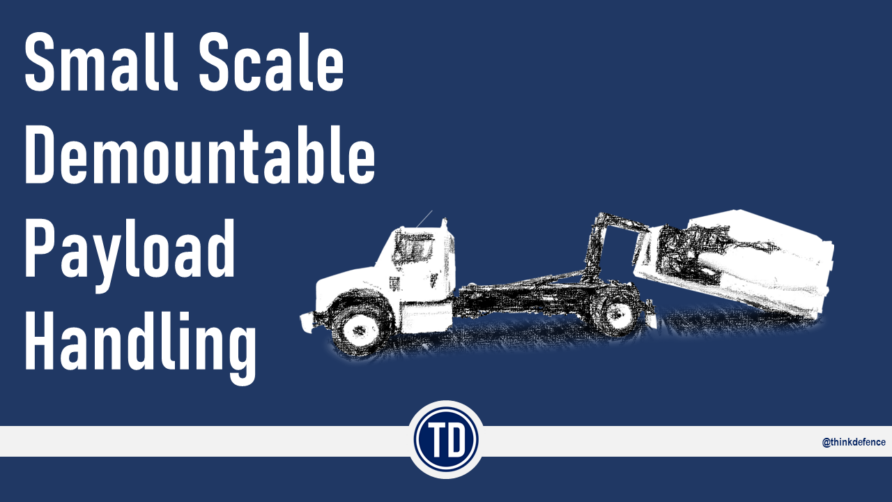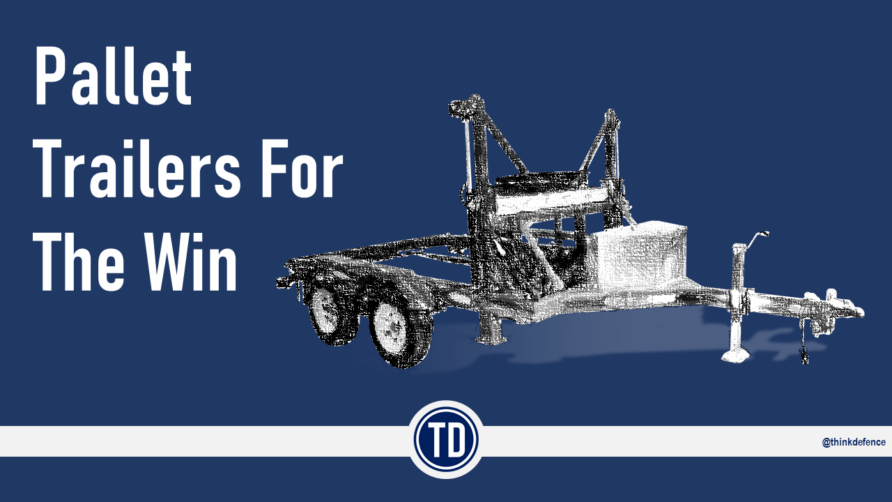Continuing the supply reduction series, this one is about water.
To restate, the exam question is: How can we reduce the frequency of resupply for small units when deployed?
Water is essential to life.
A blindingly obvious thing to say of course, but military operations rely on a constant supply of potable (suitable for drinking) and palatable (pleasant to drink) water, not only for those personnel involved but potentially, civilians and prisoners of war as well.
Water supply is part of the wider subject area of military hydrology that also covers the influence of water on mobility, contamination of water sources from military activity, and water as a source of conflict.
Geology and hydrology are both essential components of any campaign plan.
Water Supply Basics
I will look again at water supply in the future, likely in a series of its own, so this is a short version of water supply basics.
How much water is enough water?
Usage will depend on many factors; physical activity, environmental conditions, medical requirements, food types (e.g. dehydrated versus retort pouch), sanitation requirements, and many other factors. Vehicles have water demand, decontamination systems also, and even cooling equipment might require water.
In Afghanistan, as one might imagine, it was 10 litres per day for drinking only in some cases. In the Gallipoli campaign in WWI, Australian forces had to make do with 1.5L per man per day, resulting in obvious hardship and health issues. It is also important to understand that in hot environments where sweat loss is high, consuming large volumes of water without salts can also cause problems.
During recent operations in Mali, it went from 14 Litres per day, down to 4.
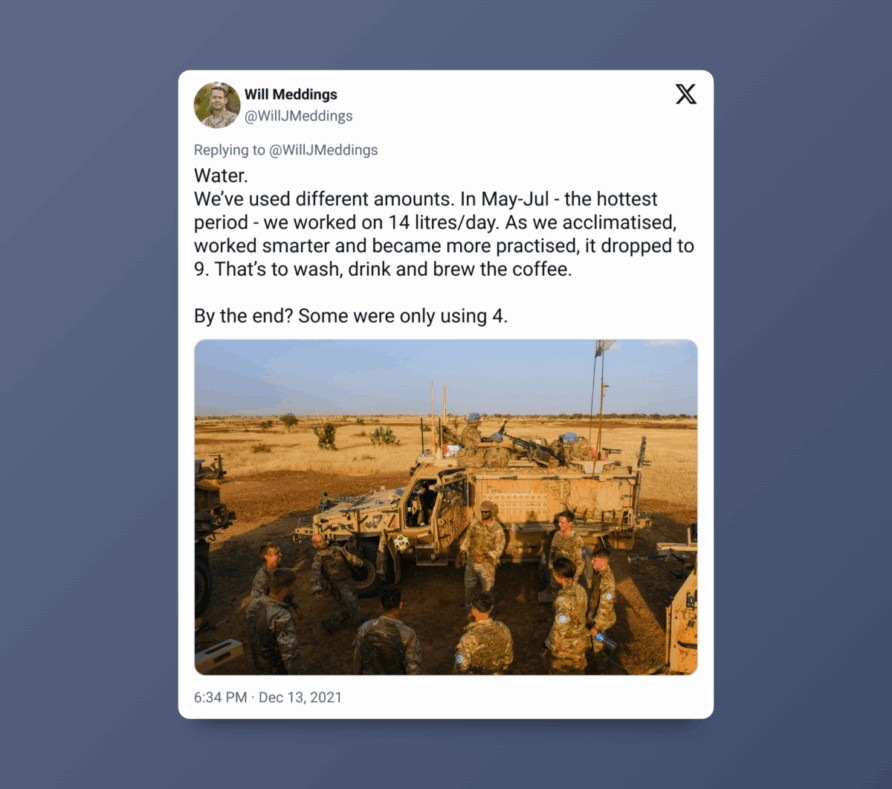
Water Supply Components
There are three basic components in water supply.
Raw water
The availability of raw water and degree of contamination can vary dramatically by season and location.
Raw water can be found in the obvious places like lakes, rivers, streams, and ponds, but it can also be obtained from industrial and domestic buildings, stand pipes, and water tanks.
There may be some scenarios where seawater or brackish water is a suitable source.
Snow can be melted, and in some cases, water pressure may still be available, so it might be as simple as turning a kitchen or garden tap on.
Treatment
In a defence context, no source of raw water should be assumed to be safe, it must be treated in such a manner that potable or palatable water results.
Biological contaminants cause waterborne disease, many of which are debilitating and often fatal, bacteria, worms, protozoa, and viruses can all be present in contaminated water. Salts, metals, pesticides, hydrocarbons, plastics and industrial chemicals are other considerations. Some of these are grouped into the terms, Toxic Industrial Chemicals (TIC) and Toxic Industrial Materials (TIM).
In a defence context, radioactivity and other weapon contaminants are also possible.
Water with a high level of suspended matter can be subjected to pretreatment to improve the efficiency of subsequent steps.
Removing suspended matter can be accomplished physically, typically with simple gravity filters such as a Millbank bag, or with a flocculant agent.
Boiling can be used, but it requires fuel, and does not address all contaminants. Chemical disinfection is simple and easy to use, but like boiling, will not address all contaminants. Ultraviolet purification is another method, using sunlight or artificially produced UV, but like the previous two methods, it too does not address all contaminants.
These are time proven methods, but more recently, advanced ceramic, graphene and activated carbon filtration media has offered much greater effectiveness and efficiency, even at small scale. Reverse osmosis and mineralisation are other techniques to produce high-quality water, even from highly contaminated sources.
This diagram from Bluebox provides a good overview of the particle/filtration sizes of various contaminants
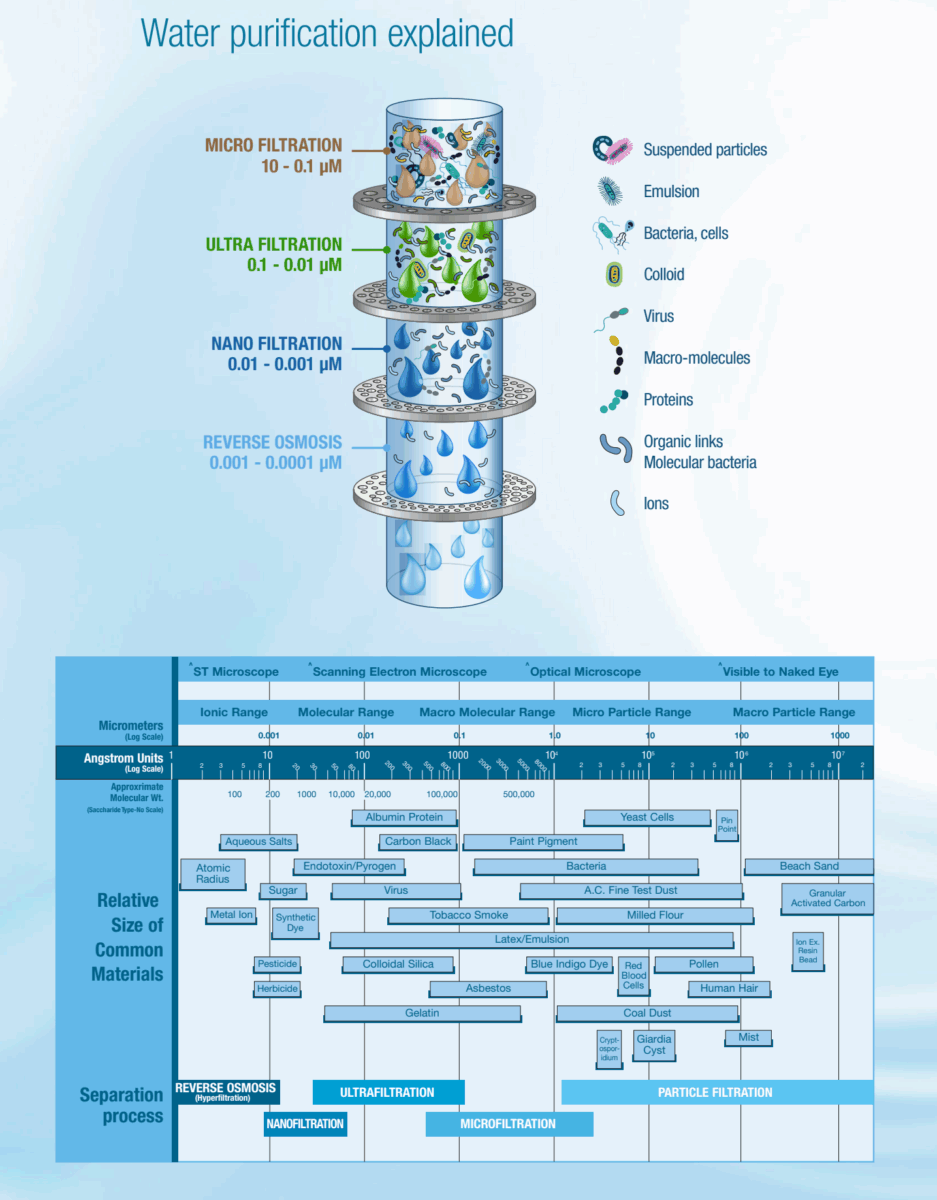
In theory, almost any source of raw water can be treated, but risk and benefit versus effort must be considered. Treatment involves cost, training, safety, effectiveness and efficiency, these will factor into the selection of methods.
Storage and Distribution
Treated water can be distributed in bulk or in small containers like jerry cans or individual bottles. In some less frequent cases, rapidly deployed pipelines can also be used to distribute treated water.
Although water distribution does not necessarily use all these modes of transport, from left to right, the Close Support Tanker (Water), Water Dispensing Rack, Water Carriage Pack, Jerry can, and water bottle.
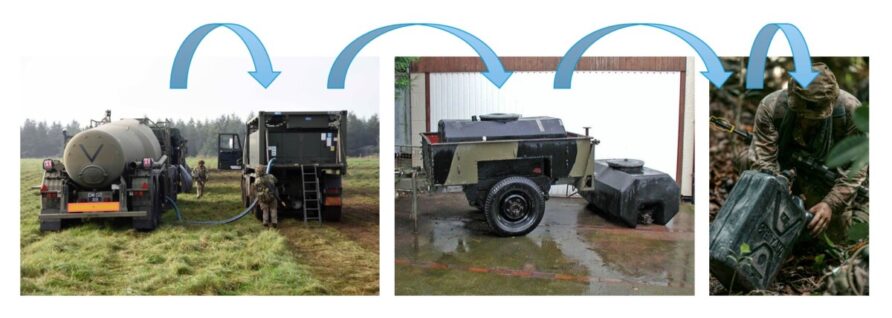
Bottled water can also be transported by the container and pallet load, and has the advantage that the bottle will be contamination free all the way to the point of use. Bulk water distribution introduced potential for contamination at each change of transport mode.
Issues for Resupply Reduction
Putting the issue of treated water versus bottled water aside, the fundamental problem for resupply reduction is twofold.
- First, there is not a huge amount of scope for water consumption reduction
- Second, the dilemma of centralised versus forward treatment
For sustained operations, it is challenging to reduce water demand. Using whole body wipes and stopping shaving may be a good enough method, but it might not make a massive dent in demand.
Centralising potable water generation is efficient. It allows skilled resource (including contractor support) and high throughput equipment to focus on a singular task. This method can generate significant quantities, store it, bottle or package it, and send it on its way.
Quality can be guaranteed, checked, assured, traced, and it will have high degree of acceptance, this is why the British Army and KBR established ‘Bastion Water’. Whilst efficient, and with high-capacity and quality, in a more contemporary operating environment, it is a rather large single point of failure. It also requires every single litre of water to be transported through each echelon.
The new(ish) Combat Water Supply System (CWSS) seeks to address this vulnerability (although it also features a large containerised treatment and pouching system), and replaced a lot of legacy equipment.
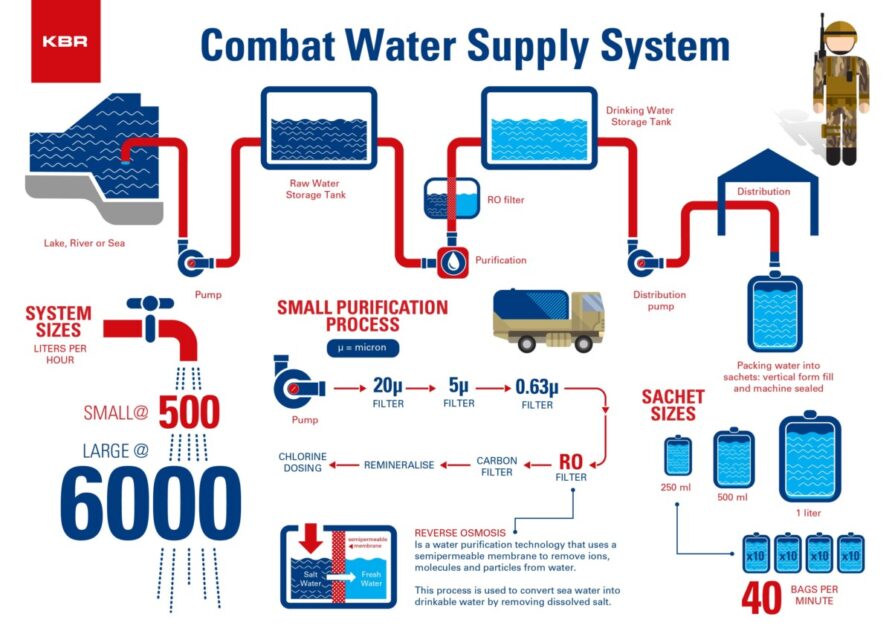
CWSS requires power.

Water produced by the CWSS may be stored at the treatment location in pillow tanks or pumped directly into tankers and containers.
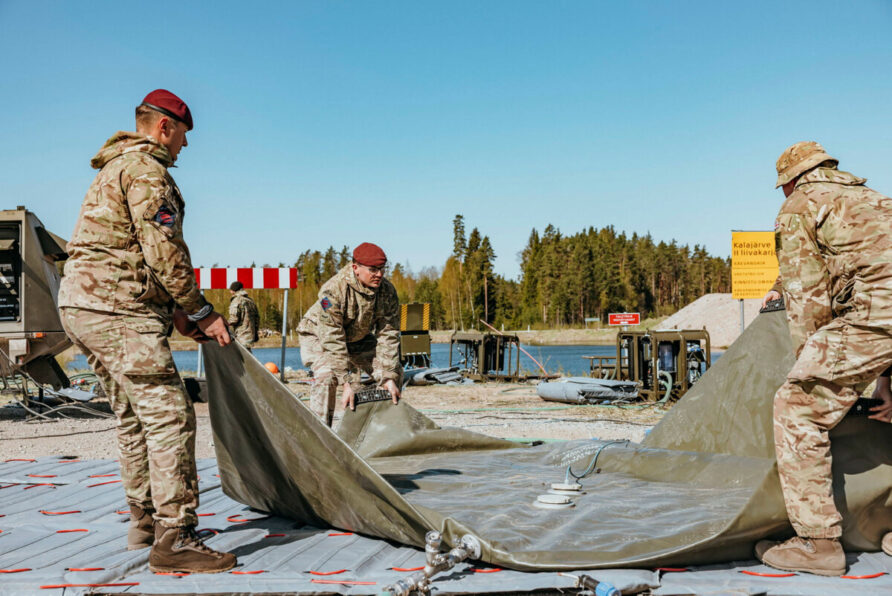
At around 500 to 1,500 litres per hour, this is a capable system.
It takes an hour to set up.
This is one of the fundamental problems we face on a modern battlefield, where 30 km plus range FPVs might be more common than we like. These systems can be camouflaged and distributed, but takes a while to set up, and are vulnerable to even minor damage.
Implementing smaller scale water treatment systems that are closer to the F Echelon could improve resilience and reduce risk during resupply, but there are numerous disadvantages.
- It means consuming precious time in fighting units
- It would need more training in combat units to ensure quality
- It is significantly less efficient
- The equipment has to be transported
- It is likely more costly
There are no free lunches with any of these discussions, you mitigate risk in one area, and add different ones in another.
Living off the Land
Living off the land, for water, carries risk, but it may be possible to offset some of that risk by reducing resupply, whilst not completely eliminating it.
Water Scavenging
It is quite possible that in many operational areas, mains water pressure will be maintained, at least for a time. Even if mains water supply is closed down, water may remain in pipes and storage tanks in industrial, commercial and domestic buildings.
Three or four houses, each with a garden water butt, is an hour of CWSS operations. Water in heating systems or industrial equipment would generally be avoided, but could be used for non-drinking purposes.
With some knowledge, and basic hand tools and equipment, significant volumes of raw water can be scavenged. As a minimum, lay-flat hose, manual kayak bilge pump, adjustable spanner or pliers, flexible containers, and hose couplings and manifolds will enable this resource to be exploited.
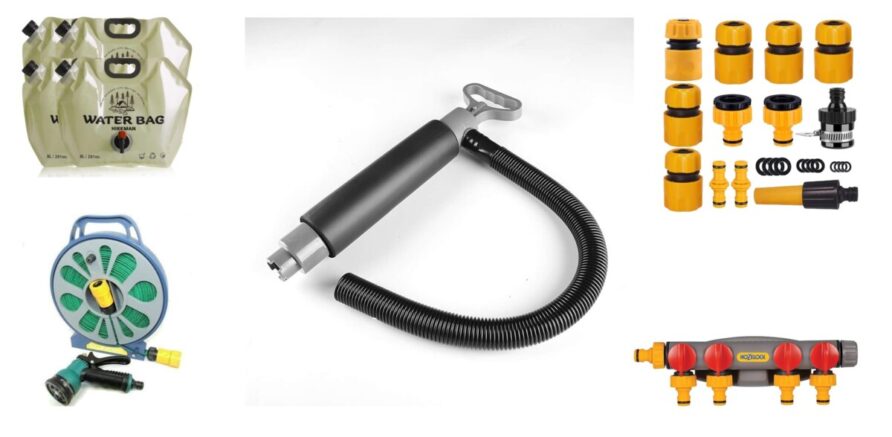
None of these require power, and all of it would be dirt cheap, it simply does not need to be ‘military grade’. It could be a challenge to see just how cheap you could get it.
A standpipe tap and fire hydrant keys/fittings would be a useful addition to the scavenging kitbag.
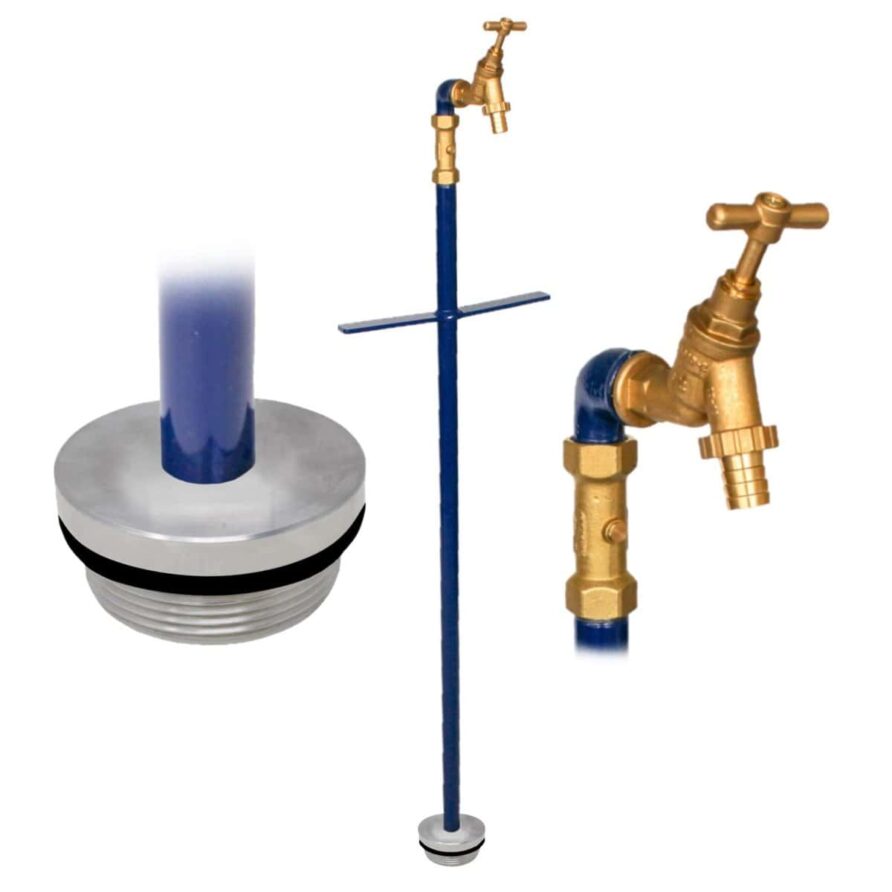
Although, these might need to be theatre-specific.
Rainwater Harvesting
Rainwater harvesting can be used in fixed or semi-fixed locations to obtain untreated water, or even on vehicles.
To determine the amount likely to be harvested from a given area, a simple calculation can be used that multiplies roof area by rainfall intensity, multiplied by a yield coefficient, typically 0.9. A typical domestic property with a 60m2 roof, with a light to moderate rainfall rate of 8 mm per hour, yields about 430 Litres per hour.
Flexible temporary plastic drainpipes are used in the building sector to safely guide water away from semifinished construction projects, it comes on a 20m roll, with a couple of cable ties, and costs a tenner for 20m of the stuff.
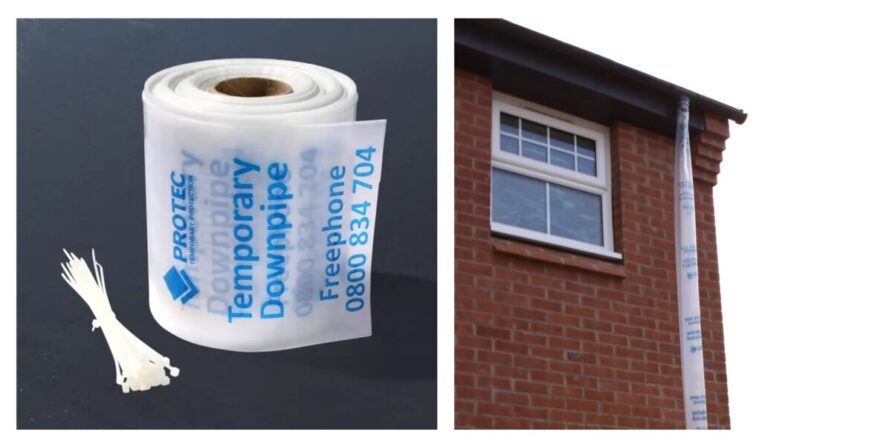
These can be used to direct rainfall from a roof to a jerrycan or other container, ready for treatment later.
In other settings, fabric collectors can be used.
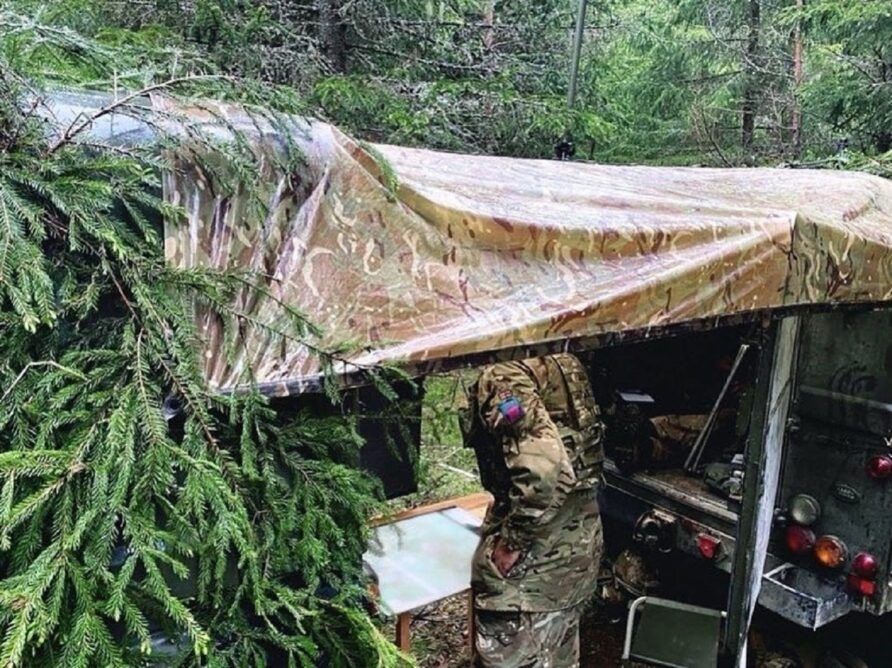
Knock in drainage grommets convert simple tarpaulins into water collectors, or if the integrity of the sheet is retained, water diverters like the HH20 system shown in the image below right are a suitable alternative.
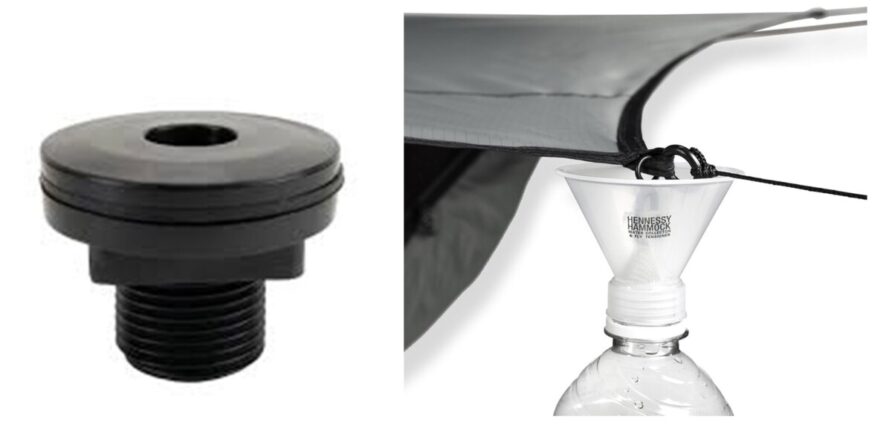
Using the same collection method as above, a 5ft (1.52 m) by 5ft (1.52 m) sheet would capture about 18 litres in an hour.
A more engineered solution is also available from manufacturers.
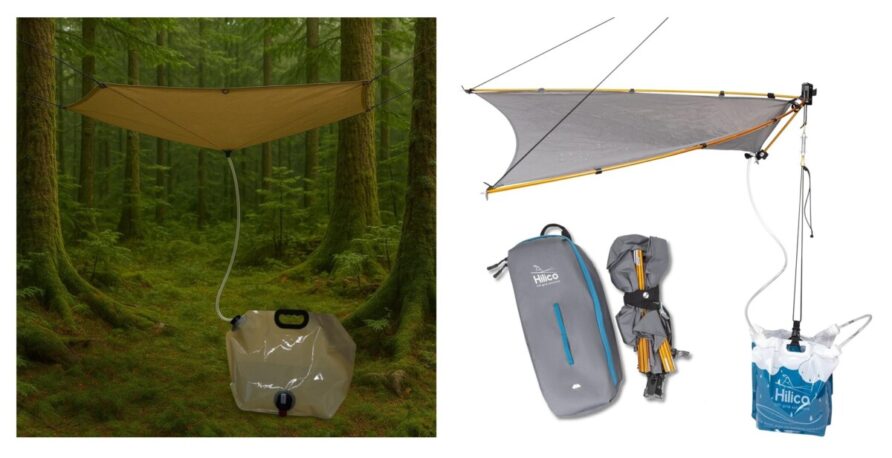
Obviously, rainwater cannot be relied upon, but it can be surprisingly effective if available.
Evaporation
Evaporation is a technique used for escape and evasion (survival), but this is perhaps at the extreme end of the water scavenging scale.

Included here for completeness.
Raw Water Storage and Transport
Whether scavenged or collected, untreated water has to be stored and transported, separately to treated water.
There are many cheap, semi disposable plastic water containers, and even collapsible barrels that come in a bag and cost thirty quid.

Or we could just use the in-service plastic jerrycan.
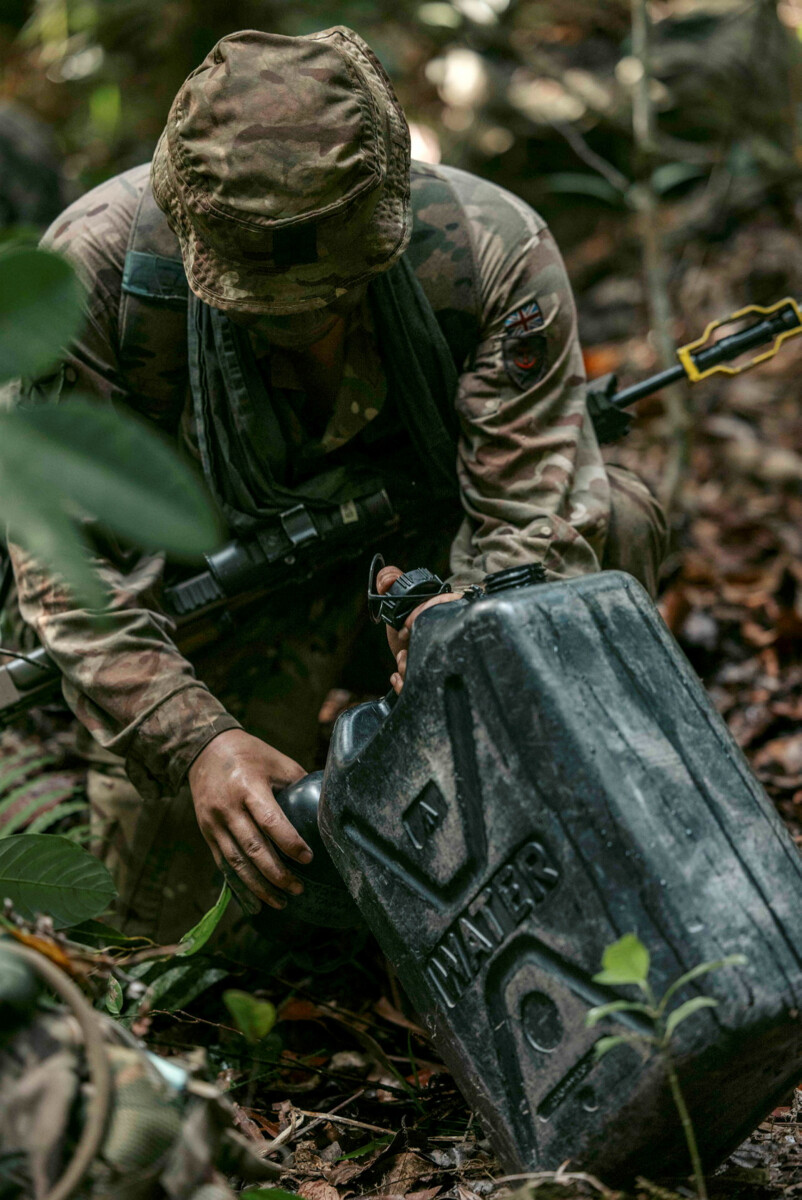
An infantry handcart would be of obvious value, or even a rolling water container, there is no shame in looking like a caravaner, they contain 40 Litres and cost less than forty quid.
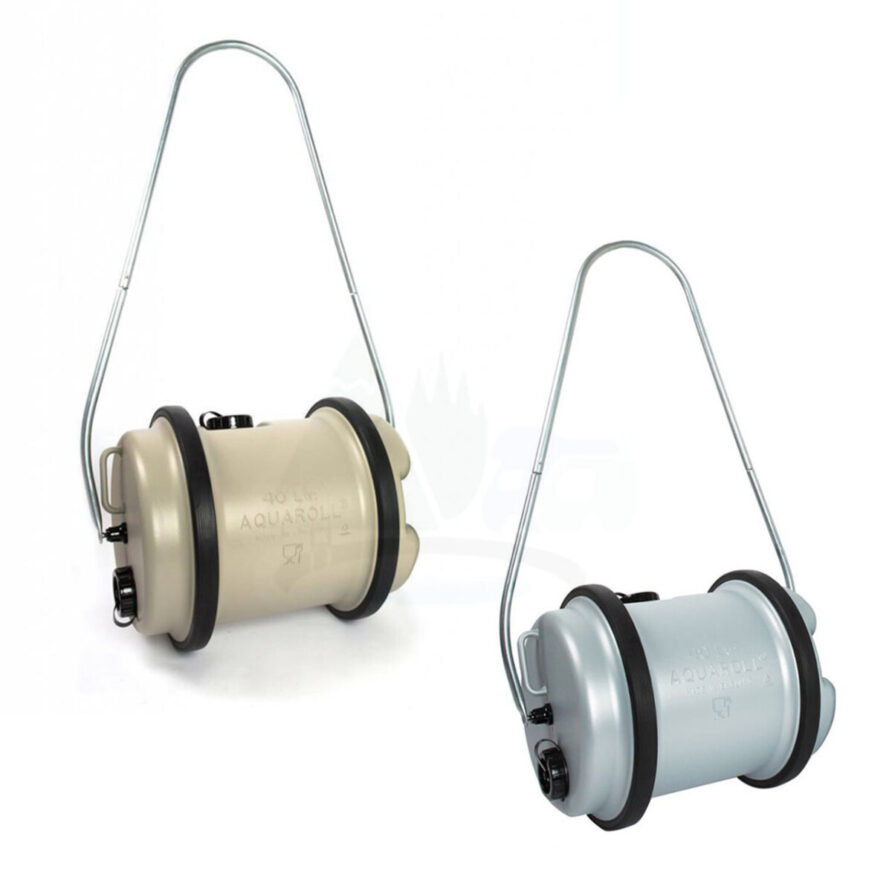
As with collection and scavenging equipment, all these are cheap enough to be disposable.
Small-Scale Water Treatment
By small scale, I mean below the lowest CWSS throughput, company, platoon and section scale, not brigade and battalion.
Pre filtration using a Millbank Bag (or modern equivalent) separates suspended particles. Untreated water is scooped or poured into the bag, and filtered with gravity assistance into a water bottle or similar container.
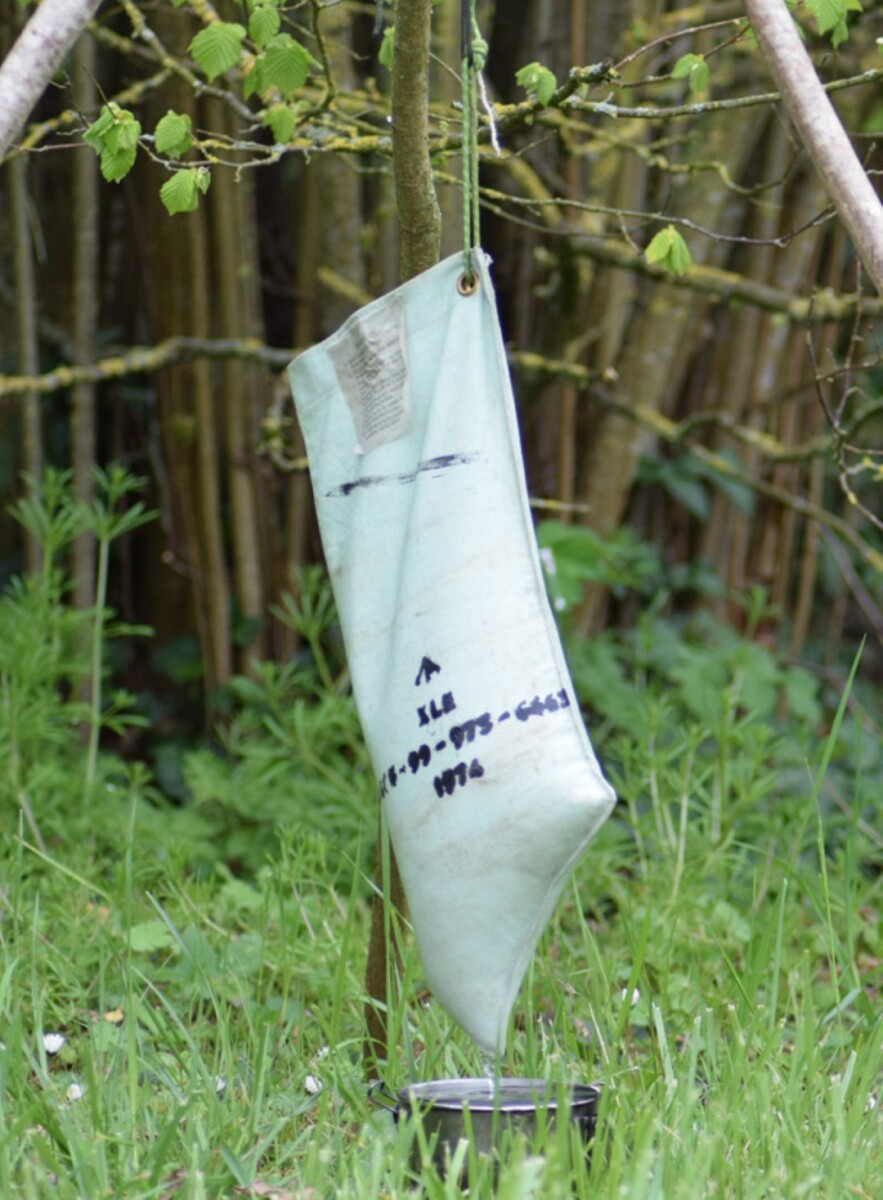
The residual water is then further treated by boiling or with a chemical agent such as a purification tablet. Boiling, especially with high-efficiency portable stoves like a Jetboil or even Kelly Kettle, can be relatively effective and quick, although they need fuel and will generate a thermal signature.
These are time proven methods, but technology marches on, and the Puribag is a modern take on simplicity in water treatment.
The Puribag is an interesting design because of its simplicity, combining chemical treatment with a flocculant to quickly remove sedimentation without filtration.
Moving up to filtration systems, brands such as MSR, Sawyer, Lifestraw, and Katadyn will be familiar to many outdoor enthusiasts. The MoD has trialled/issued various similar products in the past, Lifesaver and Pure Hydration for example.

Both are UK base, and both are still going.
The Lifesaver Liberty is the latest version of the older Lifesaver bottle, and has an integral pump.
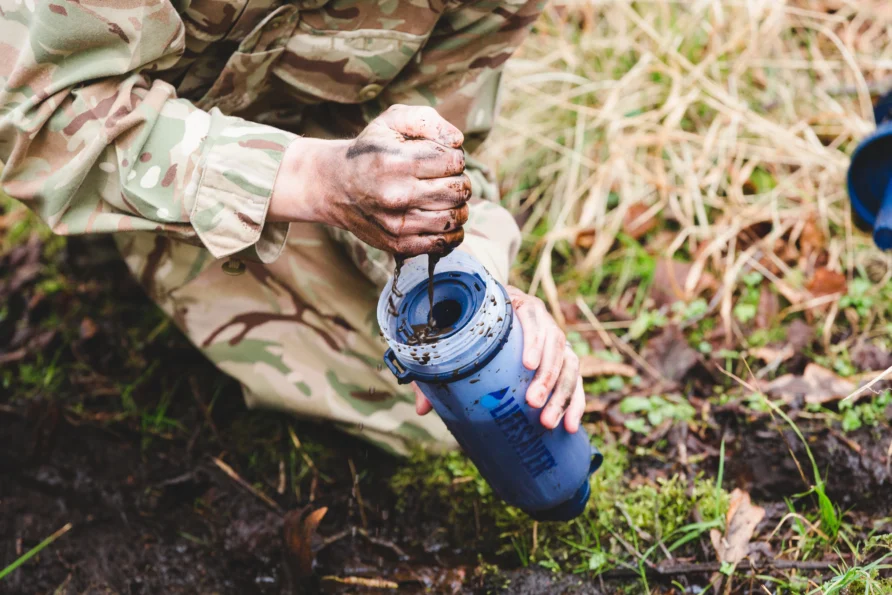
Pure can also provide a 58 Pattern Water Bottle attachment
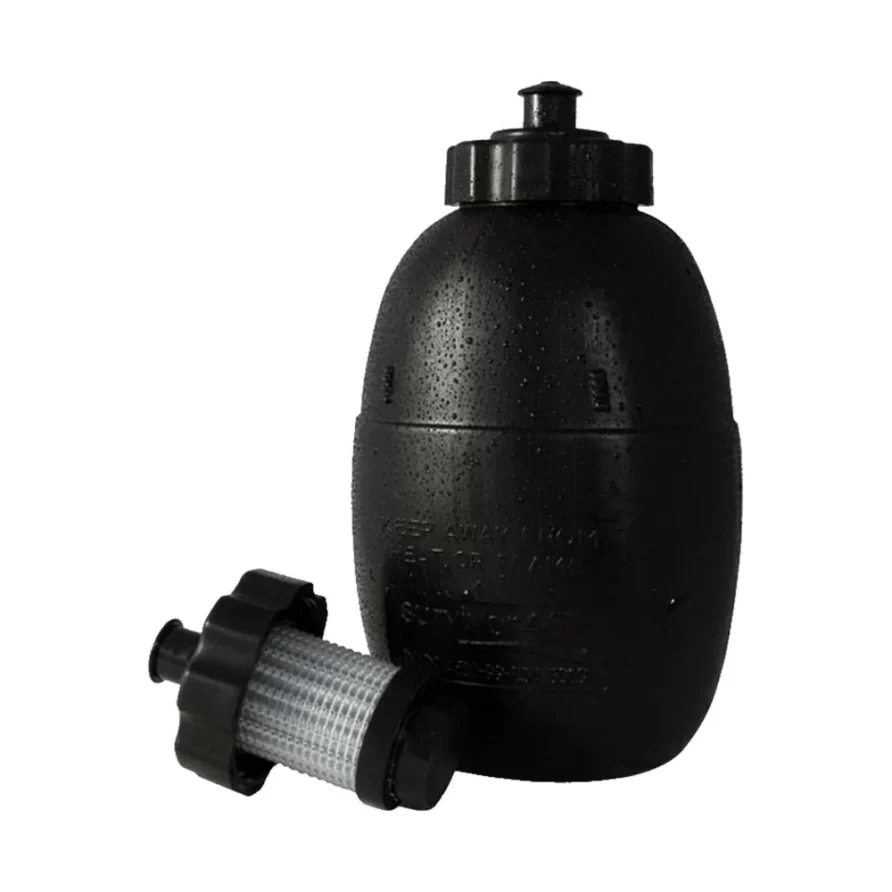
Back to Lifesaver, the Wayfarer is a lightweight and compact pumped portable water filter.
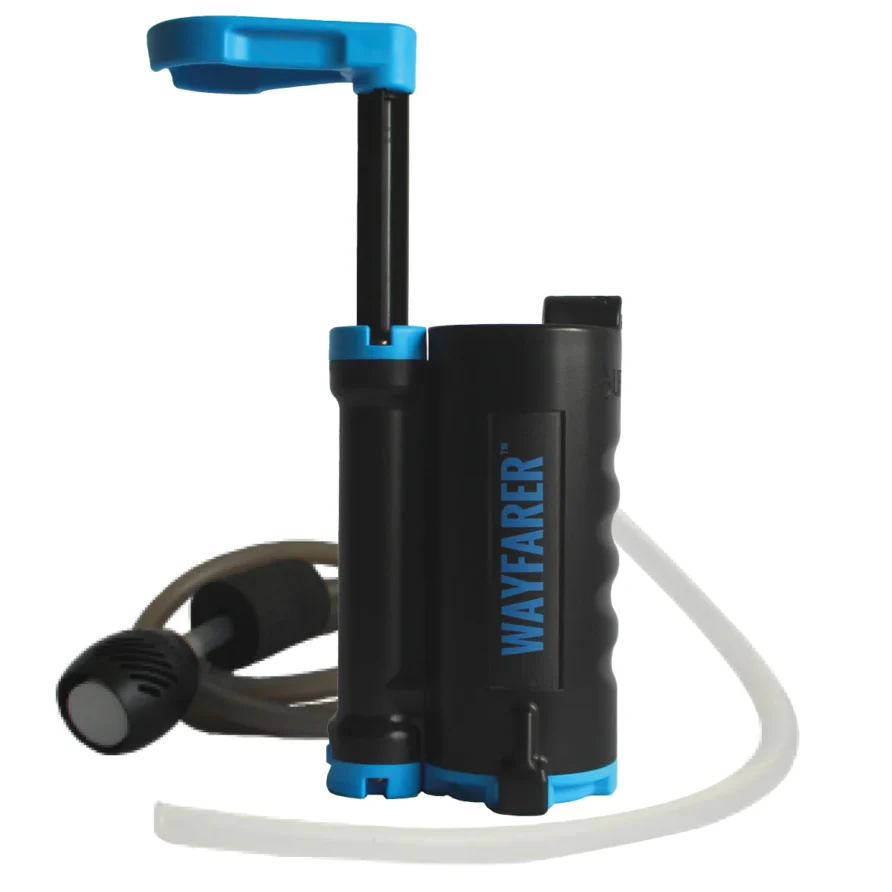
Weighing less than 350g, it can process 1.4 litres of water per minute.
Moving up in scale, the Lifesaver Jerrycan is a mature product that has recently been dramatically improved with the addition of a Graphene filter cartridge option.
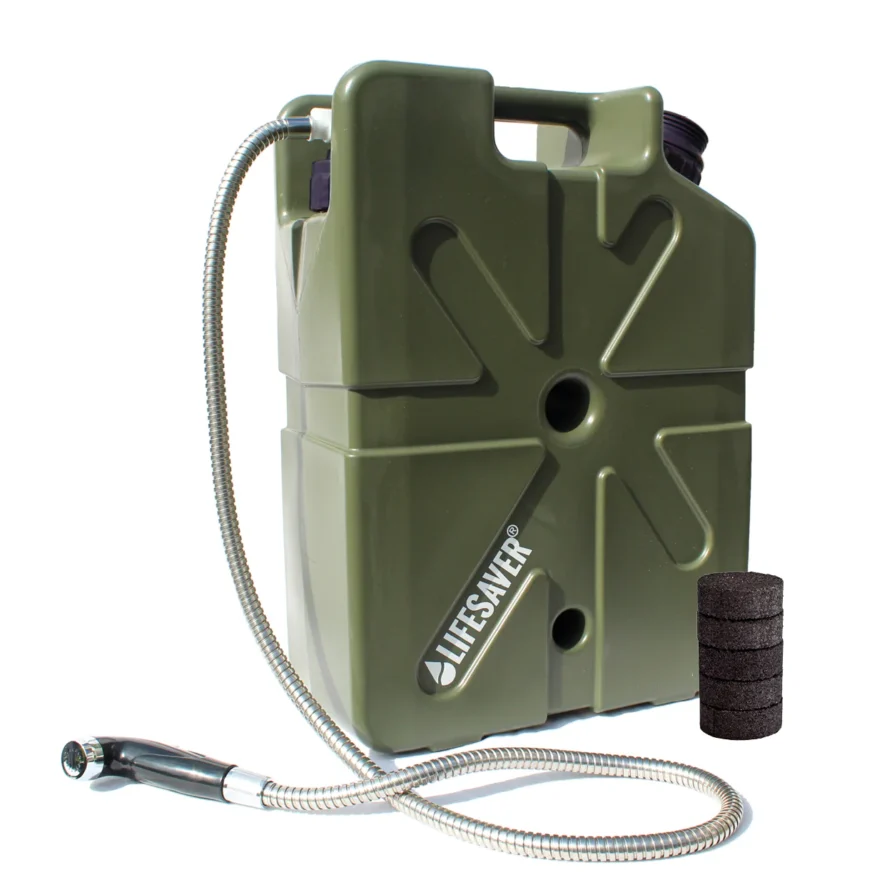
Per and polyfluoroalkyl substances (PFAS), often referred to as ‘forever chemicals’ are difficult to remove, as are chemicals and heavy metals, but the Lifesaver Graphene Jerrycan replaceable filter is said to remove these to safe drinking levels.
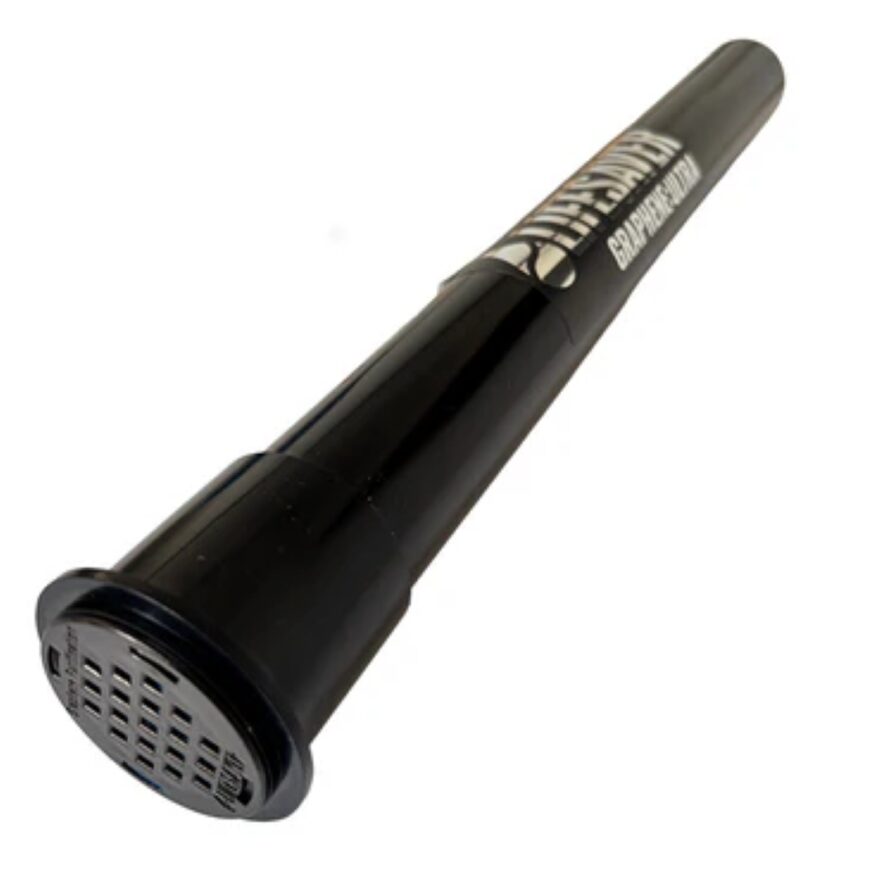
The advanced filter has a capacity of 500 Litres before it needs replacing, compared to the standard cartridge that is good for 20,000 Litres.
If water bottle and jerrycan sized equipment represents the smaller scale of equipment, there is still a gap between those, and the large CWSS, these are characterised by being packed in Peli or CP sized cases. They are still transportable, but would be operated on a collective basis.
Although no longer marked by Aquamira, the Divvy 250 filtration and chemical disinfection system is designed for medium-sized application, but it makes use of a manual pump to avoid dependency on external power.
It is packaged into a couple of carrying cases and includes a collapsible water storage cube, I wrote about this is 2014!
Small-scale manual desalination equipment is available from Katadyn.
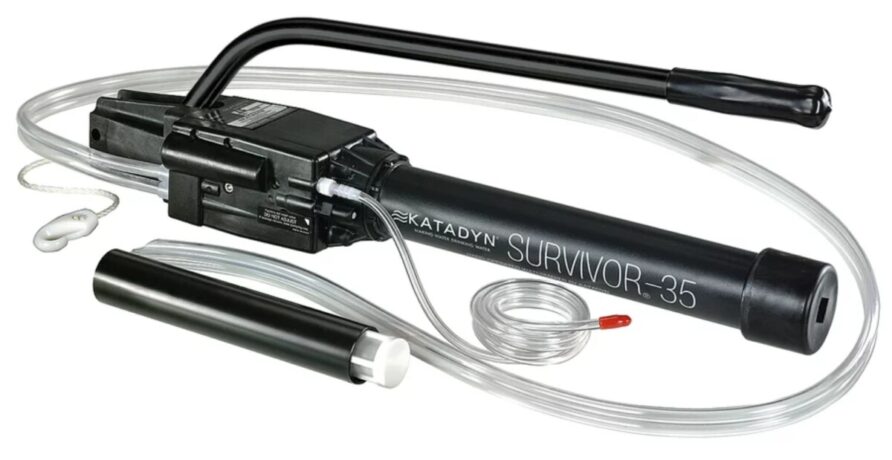
The UK designed and built Wananchi Seon UV is a battery-powered system in a Rotomoulded case, but only consumes 12 volts and can deliver up to 600 Litres per hour of treated water.
The system weighs approximately 65 kg with all the ancillaries.
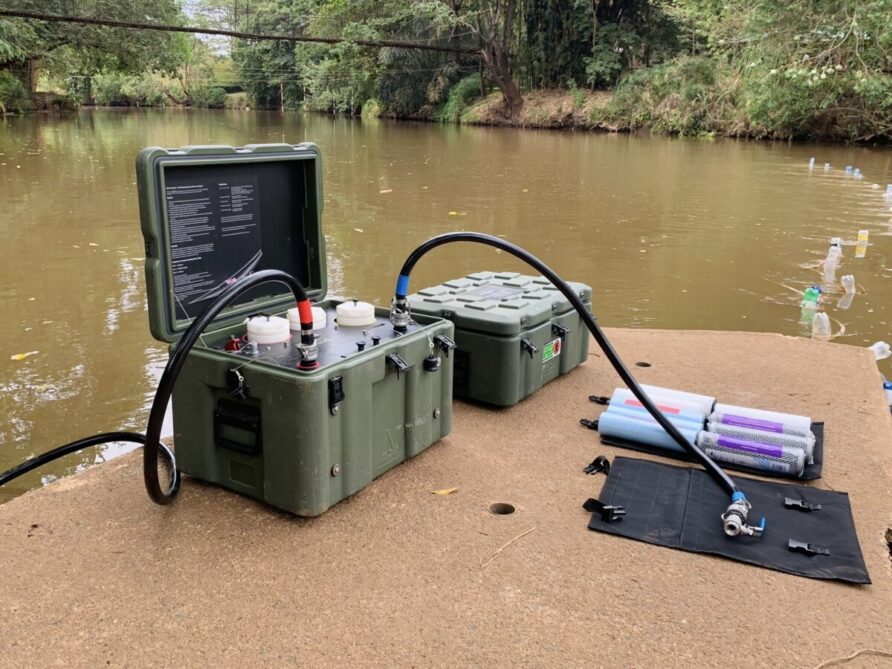
From the Netherlands, the Much More Water Bluebox 140, available in the UK from Butek Landline, is a high-efficiency mobile water purification unit that produces 140 Litres per hour, making use of Reverse Osmosis filtration membranes to process seawater and brackish water.
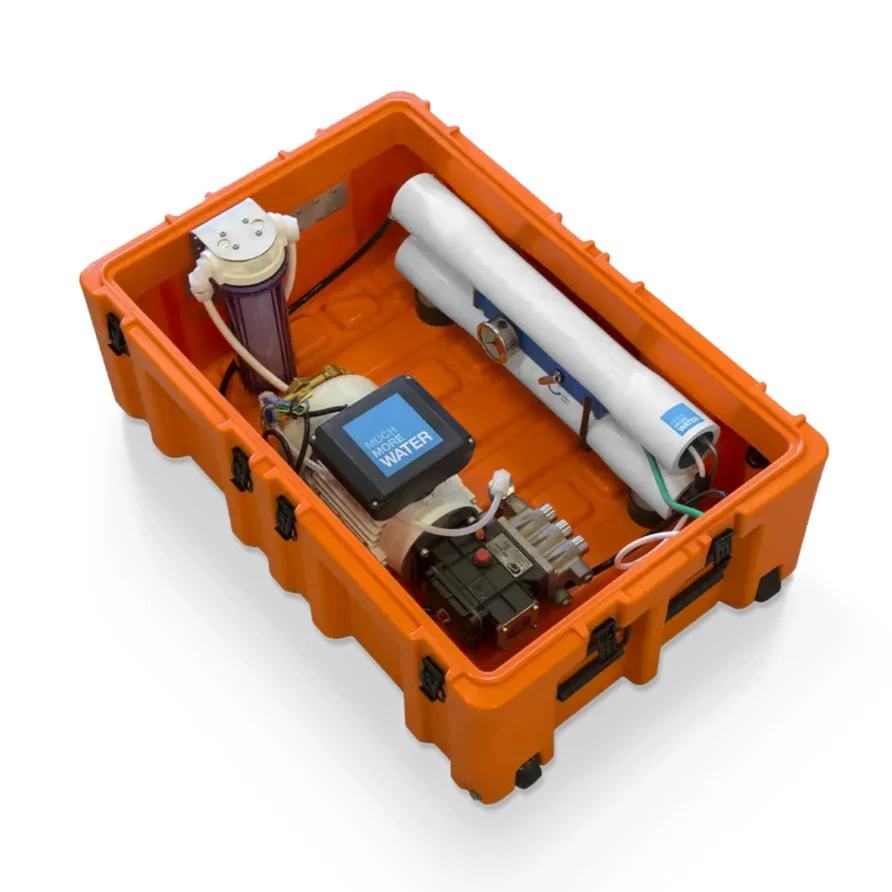
Recognising that reverse osmosis requires input significant pressure, the unit consumes 1.3Kw of electricity at 220/230 volts.
The Platoon Reverse Osmosis System (H2O-PRO) from Parker Hanafin, from the USA, is a similar system.
The two box system weighs 118 kg and can generate 100 Litres per hour.
I have excluded vehicle-based systems like atmospheric moisture recovery systems and MoD funded research projects, but both will have broader applicability.
Water Transport
Most of the approaches described above are specifically designed to reduce transport, but transport cannot be eliminated completely.
There is a lot to be said for retaining the standard plastic jerrycan, not least because it is compatible with various transport racks, pallets, and storage solutions.
Vehicles like the Babcock GLV have onboard storage for jerrycans (fuel or water)
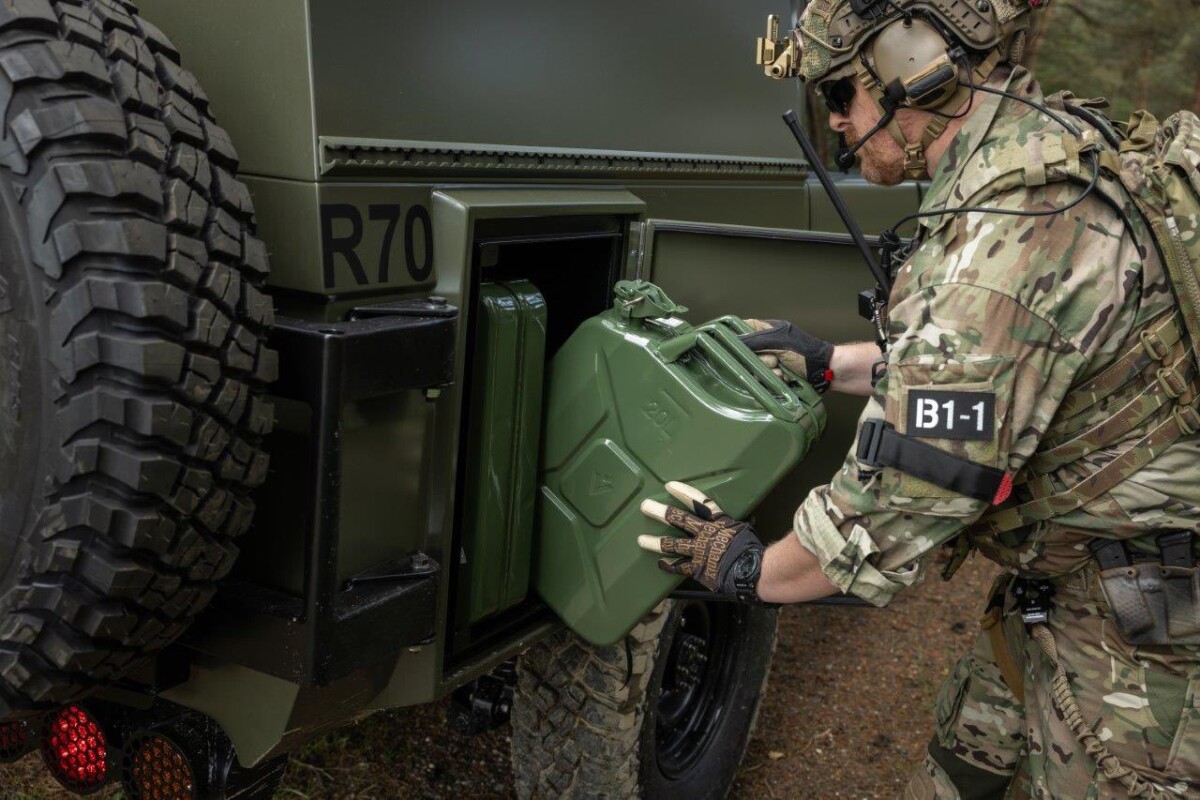
The form factor is also similar to the Lifesaver Jerrycan.
Stackable water containers might offer some advantages, they are easier to carry and provide indication of fill, and can be more efficiently stacked.
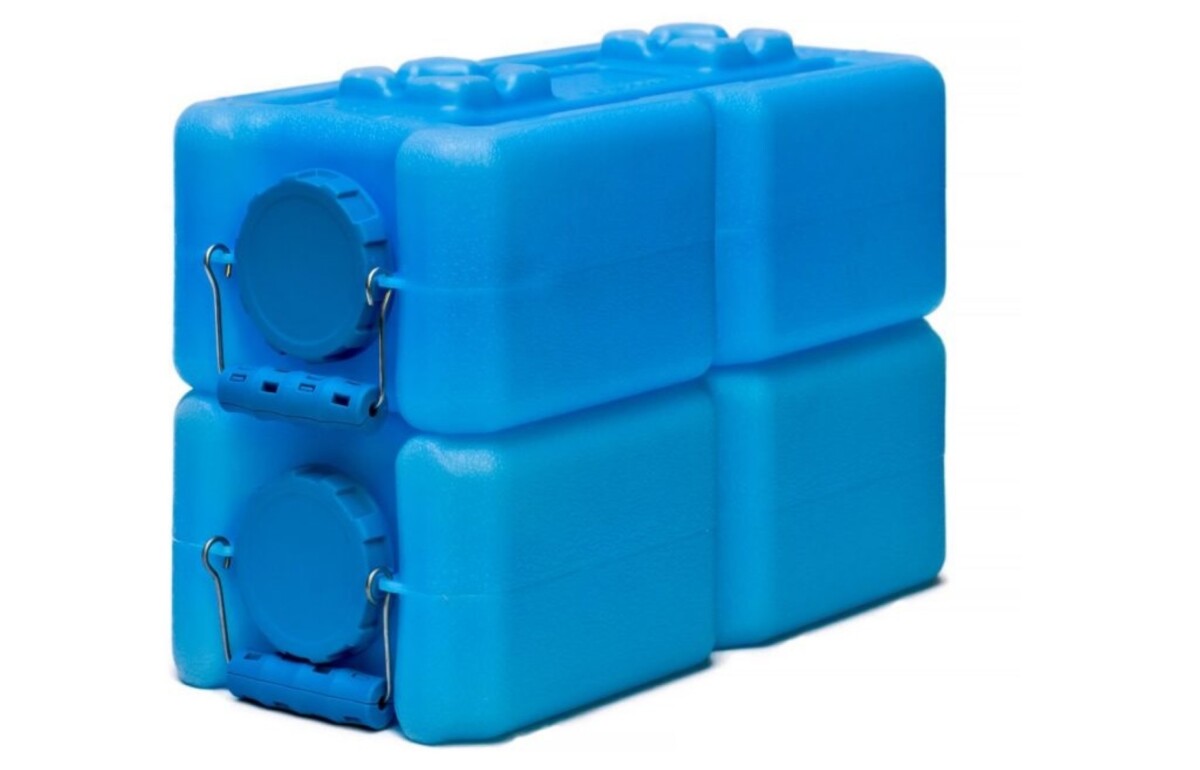
Rotopax water containers are another option to maximise carriage density, and would also be worth looking at.

But we are probably in diminishing returns territory when compared to simply retaining the 20 Litre NATO standard jerrycan
One of the issues that might be worth addressing is ‘Jerrycan taste’, the difference between potable and palatable water. This may seem a minor issue, but it isn’t. Modern soldiers have expectations based on use of clear bottles and sealing rings, and however we might wish it otherwise, this will influence hydration.
The Combat Water Supply System (CWSS) clearly recognised the increasing dependence on bottled water and has sought to address it, including a water pouching system in 250 ml, 500 ml, and 1 litre sizes. This is a smart approach that minimises the transport of PET Preforms and negates the use of blowing equipment.
Single use plastic water pouches retain the attractiveness of bottled water, without the hassle of bottles. Perhaps more of value in HADR scenarios, but certainly worth noting as they come in various materials and design combinations.
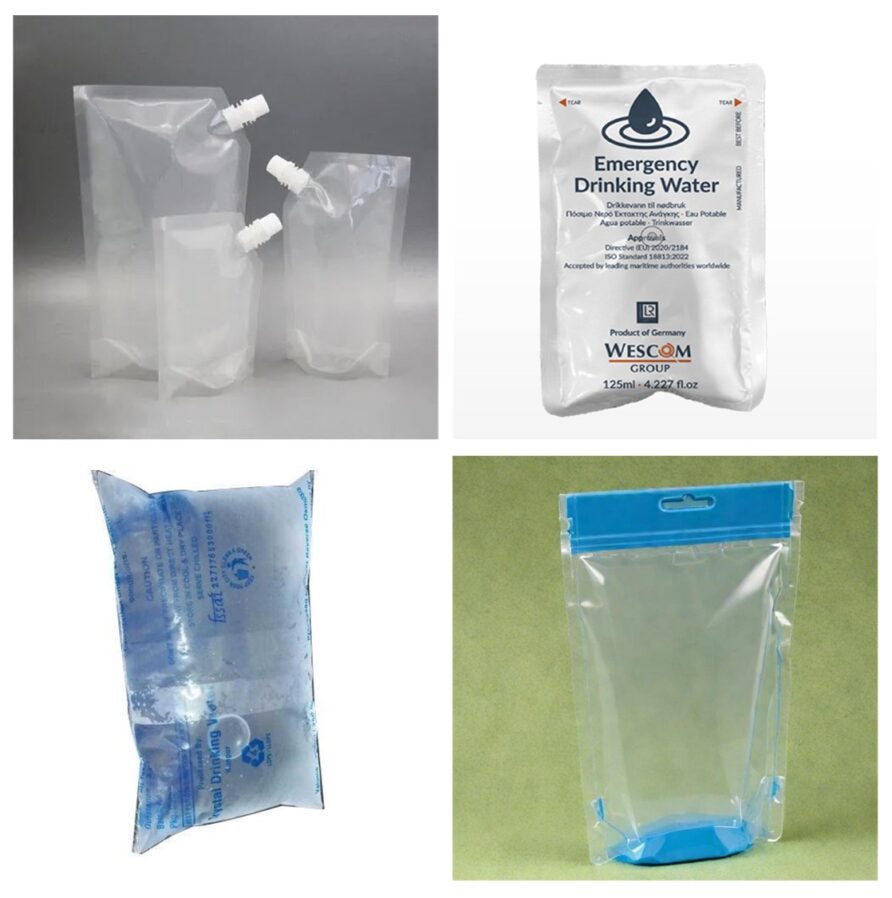
They still need transporting from the pouching equipment to point of need, though.
Back in the late early nineties, MEXE experimented with ‘bag in a box’ solutions.

A collapsible liner for a folding outer container in the same general size as a jerrycan, and with a sealing ring.
In 2015, a similar concept was showcased that won a Dyson Award. It was called the Wat’Bag and repurposed surplus fuel and lubricant containers into re-usable water containers by using a disposable liner.
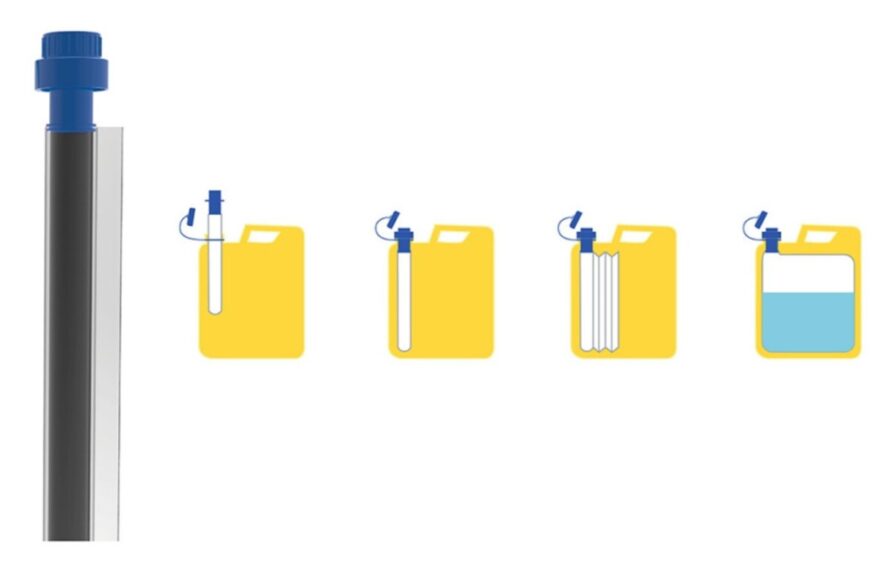
Liquid in a box is familiar to those that like wine, it uses a cardboard or plastic outer with a plastic inner.
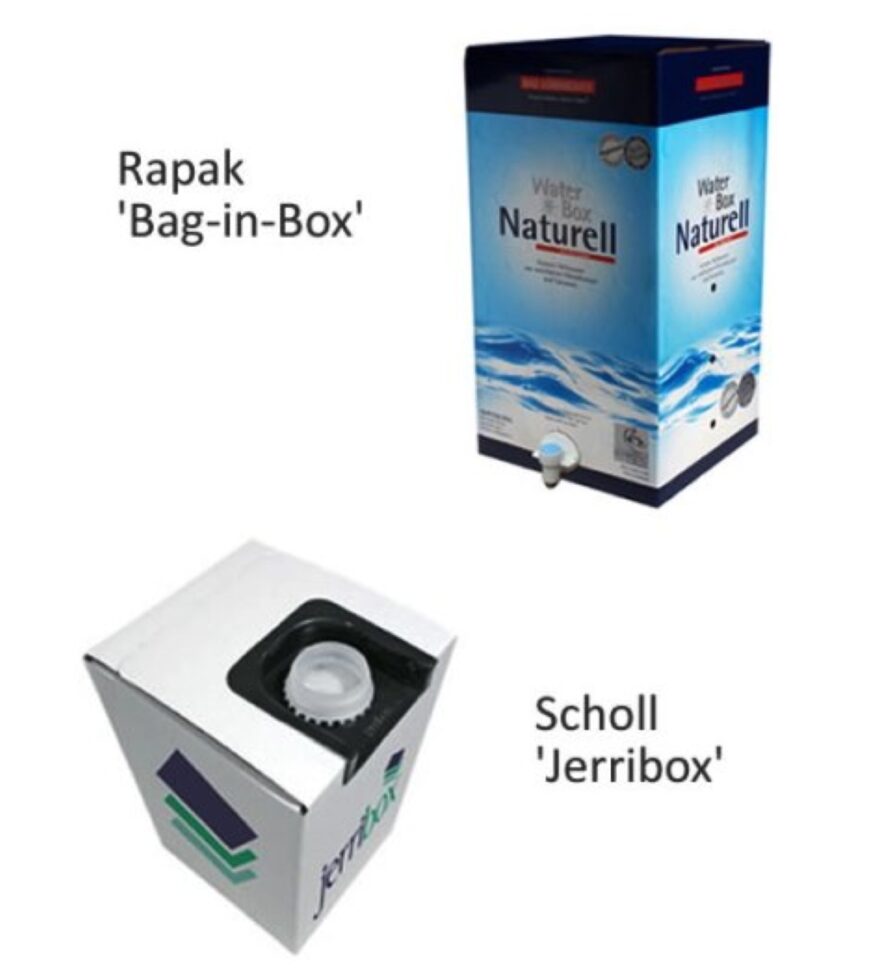
There are numerous ‘bag in a box’ solutions available from the packaging industry, all one way and low cost, whilst maintaining a contamination and taste resistant environment.
The Israeli company EZ Pack makes a flexible jerrycan with a replaceable inner liner called the Jerryflex, it looks like an interesting product.
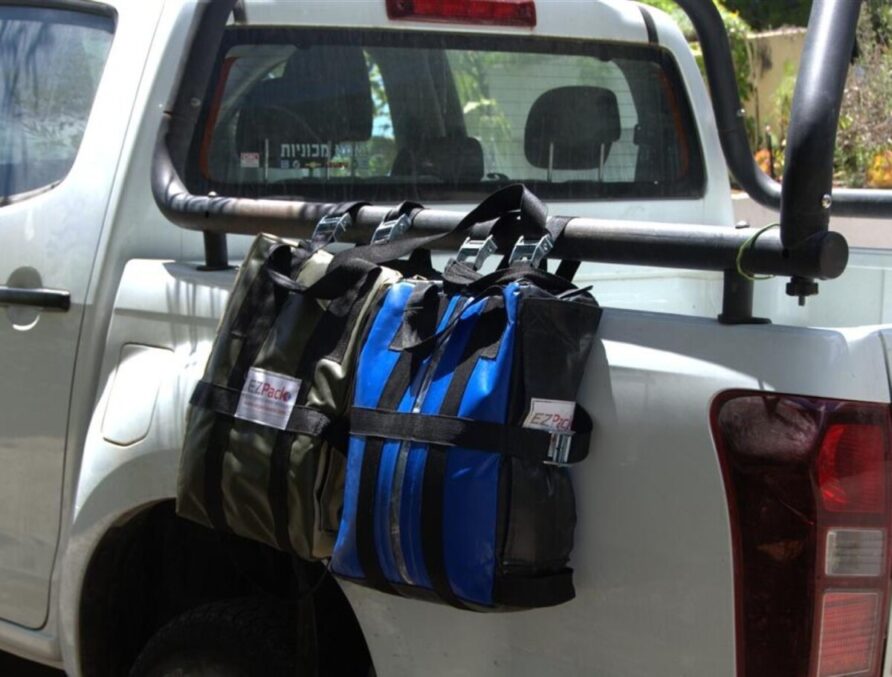
It is dimensionally compatible with the standard 20 Lite jerrycans, so will fit in existing holders and pallet boxes.
The Water Carriage Pack is actually a very well-considered design full of innovative features (and deserving of its own post), but it was designed at a time before most of the current vehicle fleet was in service (especially the quad ATV) and palletisation was more widespread.
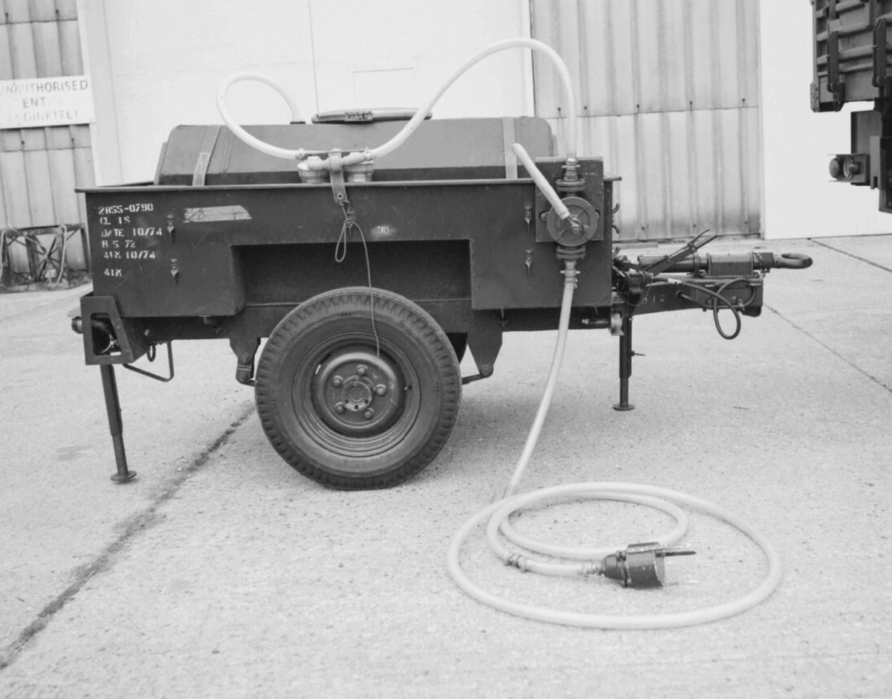
They are probably overdue for replacement now, with a design that is easy to move with a forklift and incorporate the same disposable inner liner approach to palatability and contamination control. Being more dimensionally compatible with current and planned vehicles would be an additional advantage.
It should come as no surprise, that MEXE tested a couple of ‘bag in a pallet’ systems in the early nineties.
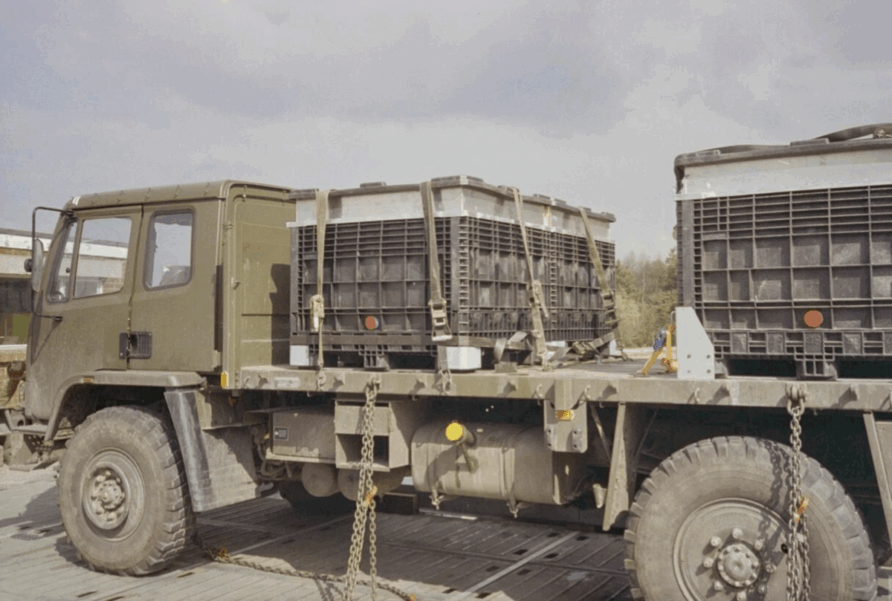
With a single use liner
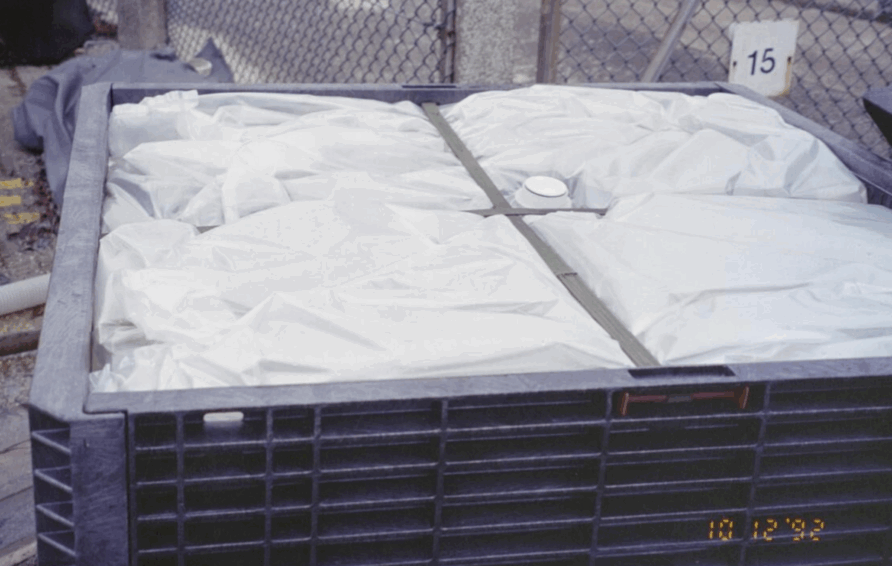
Many years later, the US Army adopted a similar system for use in Afghanistan, including a version for air despatch.
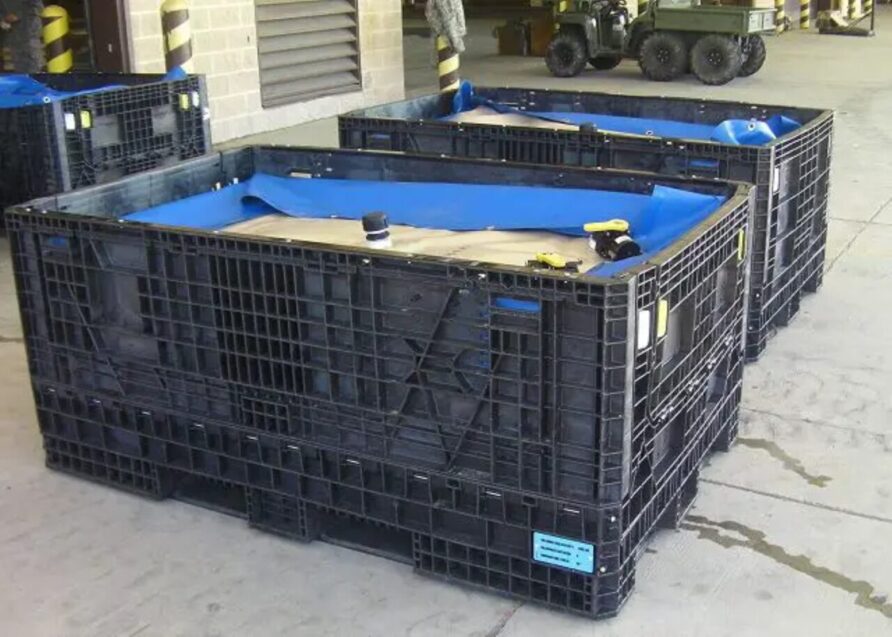
There are IBC liners and other commercial solutions available that could be used, perhaps as a pre-positioned cache (with suitable tamper evident fixtures)
Ez Pack, again, have an interesting solution for trailers and small vehicles that can be used with a loading frame that negates the need for mechanical handling equipment.
Called the Spider, it still uses the flexible outer and disposable inner approach.
I think it looks pretty neat!
None of these solutions necessarily improve transport density or efficiency, and some of them are at a size slightly beyond the scope of this post.
But they could make what is transported more likely to be consumed by eliminating cross contamination and unpleasant tastes.
Summary
Water is a complex subject, get it wrong, and you can remove a large number of soldiers or marines from the battle. We have specialist teams that look after this stuff because it is a specialist subject.
It is also a subject that is defined by numerous national, international, and defence standards.
From the outside in, the CWSS looks like a very comprehensive solution that has addressed many obsolescence issues whilst trying to get back to an expeditionary mindset and away from centrally bottled water.
But it was designed before the current ‘drone threat’ and I wonder if there is an opportunity to extend its value by looking at smaller scale solutions that retain safety and quality, whilst reducing vehicle resupply trips.
This is not a technology, or even cost issue. Most of the equipment described above is almost trivially inexpensive, but the real issues are balancing risk and changing culture.
The most intractable duo of all problems.
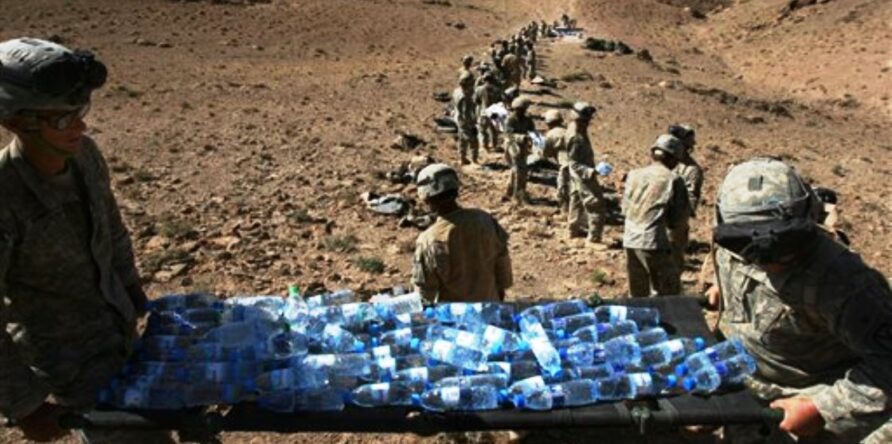
Anyway, hope this has provided some food for thought, see you in the comments.
